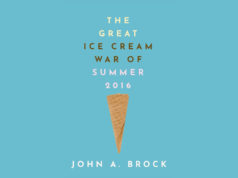There have been as many takes on the superhero genre as there are members of the X-Men. The artform has been deconstructed, reconstructed, and outright parodied. But there’s never been a superhero who gains his powers from doing drugs and drinking.
Enter: Buzzkill. The brainchild of co-writers Donny Cates (the comic Hunter Quaid) and Toadies drummer Mark “Rez” Reznicek, this four-part miniseries published by Dark Horse Comics follows the adventures of a do-gooder known only as “Ruben” whose super-strength comes from substance abuse and who is trying to get clean. With artist Geoff Shaw and colorist Lauren Affe, Cates and Reznicek have created a comic that’s one part superhero yarn and one part examination of recovery. Issues 1 and 2 are on newsstands now.
The idea for Buzzkill began when Reznicek and Cates, who was working for Marvel Comics at the time, met through a mutual friend after a Toadies concert in New York City. Six months later, Reznicek ran into Cates at a Toadies show in Austin, and not long afterward Reznicek sent Cates the idea that would become Buzzkill.
The comic isn’t influenced so much by what typical superhero comic books do but by what they don’t. “We both like comics where characterization is more of a feature than a bunch of superheroes beating the shit out of each other,” Reznicek said. “That stuff’s cool, but it doesn’t mean anything if you don’t feel invested in the characters, like in [Chris] Claremont and [John] Byrne’s X-Men or Brian Michael Bendis’ Alias.”
Cates agreed. “I’m more interested in after the battle is over and Peter Parker goes home and goes on a date with MJ,” he said.
Buzzkill is not the first comic in which superheroes and substance abuse propel the plot –– Iron Man’s battle with the bottle began decades ago. But existing storylines weren’t heavy on Reznicek’s and Cates’ minds. As a rock star, Reznicek has witnessed his share of addiction cases and understands that a lot of great music was written by addicts, but he and Cates were more interested in themes of power and abuse. “The whole comic is a choice of ‘Do I keep this power, or do I clean my life up?’ ” Reznicek said.
Cates thinks Buzzkill is a powerful metaphor for “what alcoholism does to people, what they think they can’t live without,” he said. “Getting and staying clean and your life still being intact is one of the hardest things you can do, and we’ll see how it goes for our guy.”
Striking a balance between exciting superheroics and a serious treatment of addiction was another concern. “We thought the easy way out was to play the whole thing for laughs,” Reznicek said, “but alcoholism isn’t funny to people going through it, so we decided to deal with it frankly and realistically.”
Cates brought the painful personal experience of a friendship strained due to alcoholism to the book as well. “It was therapeutic because I got to write Ruben as if he were my friend, and Ruben does things my friend didn’t, like ask for help and try to be a better person. In fact, I don’t think I told Rez this, but on page one, the people in the group are saying things, like, ‘My friend won’t talk to me’ and ‘I wake up with regret.’ That’s my friend talking, and that all came from a very real conversation, and it doesn’t get much more honest than that.”
Cates also attended several AA meetings for research, picking up quirks about the recovery process that aren’t commonly known. The meetings, he said, are “nothing like you see in movies, and not everyone’s an angel who wants to get clean. Some of them are fucking assholes who think they’re better than everyone, and the only way to show that without alienating readers is to make it happen from the reader’s point of view.”
Don’t misunderstand: The co-creators still want Buzzkill to be fun: “fun and not a total bummer,” Reznicek said, “even though it’s called Buzzkill.”
The series didn’t really come together, the co-creators said, until artist Shaw and colorist Affe got involved. Affe was a classmate of Cates’ at Indiana College of Design and colored Hunter Quaid. To land an artist, Cates solicited help from former professors, who sent him artists’ samples. Shaw, Cates said, was the unanimous choice. Cates and Reznicek were impressed by his action scenes and, more significantly, his ability to make every scene dynamic, whether it’s a fight or a conversation.
Shaw also helped define Ruben, perhaps most importantly by shooting down Cates’ suggestion that the hero sport a cape. “And you’re talking to the guy who invented the character!” Cates said. “And I just fell in love with [Shaw] all over again, because here’s an artist fighting to keep the integrity of the character alive.”
Reviews so far have been mostly positive, and the co-creators also have a few more ideas in the hopper, Reznicek said, including a rock ’n’ roll-themed murder mystery.
Cates began working on that a few months ago. “I actually conned The Toadies into letting me come on tour with them for a week so I could research it,” he said with a laugh.












